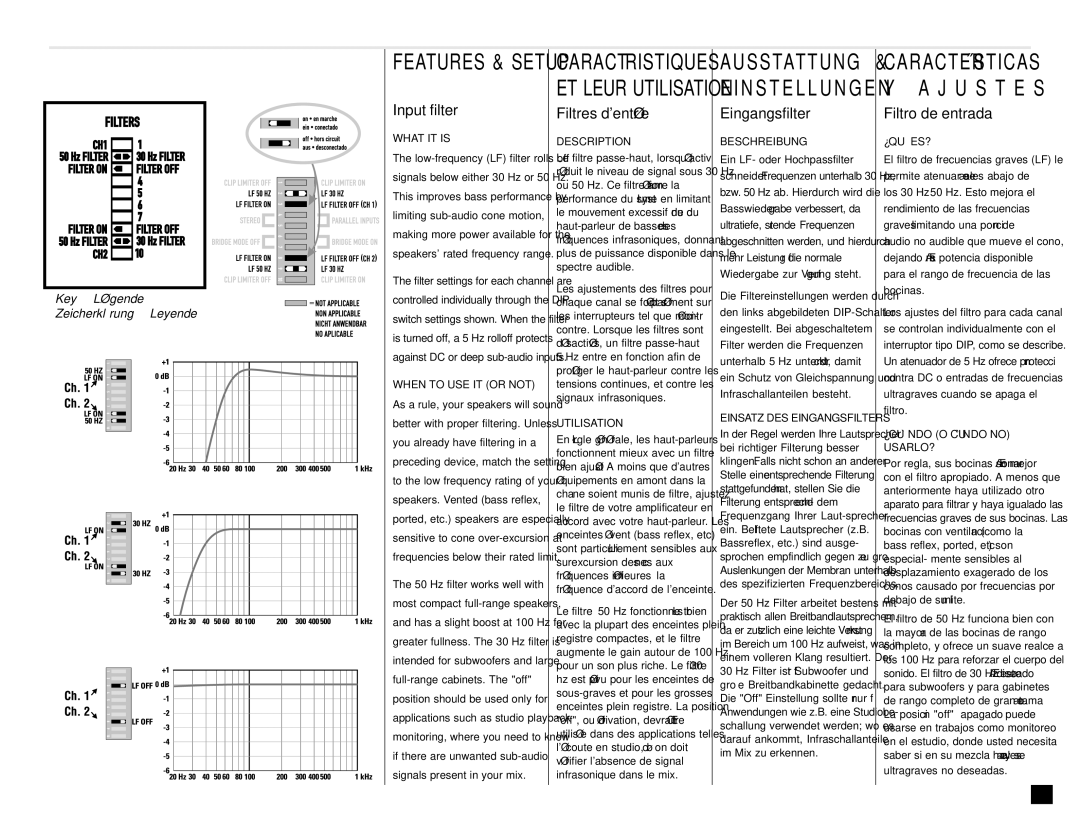Key Légende
Zeicherklärung Leyende
FEATURES & SETUP
Input filter
WHAT IT IS
The low-frequency (LF) filter rolls off signals below either 30 Hz or 50 Hz. This improves bass performance by limiting sub-audio cone motion, making more power available for the speakers' rated frequency range.
The filter settings for each channel are controlled individually through the DIP switch settings shown. When the filter is turned off, a 5 Hz rolloff protects against DC or deep sub-audio inputs.
WHEN TO USE IT (OR NOT)
As a rule, your speakers will sound better with proper filtering. Unless you already have filtering in a preceding device, match the setting to the low frequency rating of your speakers. Vented (bass reflex, ported, etc.) speakers are especially sensitive to cone over-excursion at frequencies below their rated limit.
The 50 Hz filter works well with most compact full-range speakers, and has a slight boost at 100 Hz for greater fullness. The 30 Hz filter is intended for subwoofers and large full-range cabinets. The "off" position should be used only for applications such as studio playback monitoring, where you need to know if there are unwanted sub-audio signals present in your mix.
CARACTÉRISTIQUES ET LEUR UTILISATION
Filtres d'entrée
DESCRIPTION
Le filtre passe-haut, lorsqu'activé,
réduit le niveau de signal sous 30 Hz ou 50 Hz. Ce filtre améliore la performance du système en limitant le mouvement excessif du cône du haut-parleur de basses à des fréquences infrasoniques, donnant plus de puissance disponible dans le spectre audible.
Les ajustements des filtres pour chaque canal se font séparément sur les interrupteurs tel que montré ci- contre. Lorsque les filtres sont désactivés, un filtre passe-haut à
5 Hz entre en fonction afin de protéger le haut-parleur contre les tensions continues, et contre les signaux infrasoniques.
UTILISATION
En règle générale, les haut-parleurs fonctionnent mieux avec un filtre bien ajusté. A moins que d'autres équipements en amont dans la chaîne soient munis de filtre, ajustez le filtre de votre amplificateur en accord avec votre haut-parleur. Les enceintes à évent (bass reflex, etc) sont particulièrement sensibles aux surexcursion des cônes aux fréquences inférieures à la fréquence d'accord de l'enceinte.
Le filtre à 50 Hz fonctionne très bien avec la plupart des enceintes plein registre compactes, et le filtre augmente le gain autour de 100 Hz, pour un son plus riche. Le filtre à 30 hz est prévu pour les enceintes de sous-graves et pour les grosses enceintes plein registre. La position "off", ou dérivation, devrait être utilisée dans des applications telles l'écoute en studio, là où on doit vérifier l'absence de signal infrasonique dans le mix.
AUSSTATTUNG & E I N S T E L L U N G E N
Eingangsfilter
BESCHREIBUNG
Ein LF- oder Hochpassfilter schneidet Frequenzen unterhalb 30 Hz, bzw. 50 Hz ab. Hierdurch wird die Basswieder-gabe verbessert, da ultratiefe, störende Frequenzen abgeschnitten werden, und hierdurch mehr Leistung für die normale Wiedergabe zur Verfügung steht.
Die Filtereinstellungen werden durch den links abgebildeten DIP-Schalter eingestellt. Bei abgeschaltetem Filter werden die Frequenzen unterhalb 5 Hz unterdrückt, damit ein Schutz von Gleichspannung und Infraschallanteilen besteht.
EINSATZ DES EINGANGSFILTERS
In der Regel werden Ihre Lautsprecher bei richtiger Filterung besser klingen. Falls nicht schon an anderer Stelle eine entsprechende Filterung stattgefunden hat, stellen Sie die Filterung entsprech-end dem Frequenzgang Ihrer Laut-sprecher ein. Belüftete Lautsprecher (z.B. Bassreflex, etc.) sind ausge- sprochen empfindlich gegen zu große Auslenkungen der Membran unterhalb des spezifizierten Frequenzbereichs.
Der 50 Hz Filter arbeitet bestens mit praktisch allen Breitbandlautsprechern, da er zusätzlich eine leichte Verstärkung im Bereich um 100 Hz aufweist, was in einem volleren Klang resultiert. Der 30 Hz Filter ist für Subwoofer und große Breitbandkabinette gedacht. Die "Off" Einstellung sollte nur für Anwendungen wie z.B. eine Studiobe- schallung verwendet werden; wo es darauf ankommt, Infraschallanteile im Mix zu erkennen.
CARACTERÍSTICAS Y A J U S T E S
Filtro de entrada
¿QUÉ ES?
El filtro de frecuencias graves (LF) le permite atenuar señales abajo de los 30 Hz ó 50 Hz. Esto mejora el rendimiento de las frecuencias graves limitando una porción de audio no audible que mueve el cono, dejando más potencia disponible para el rango de frecuencia de las bocinas.
Los ajustes del filtro para cada canal se controlan individualmente con el interruptor tipo DIP, como se describe. Un atenuador de 5 Hz ofrece protección contra DC o entradas de frecuencias ultragraves cuando se apaga el filtro.
¿CUÁNDO (O CUÁNDO NO) USARLO?
Por regla, sus bocinas sonarán mejor con el filtro apropiado. A menos que anteriormente haya utilizado otro aparato para filtrar y haya igualado las frecuencias graves de sus bocinas. Las bocinas con ventilación (como la bass reflex, ported, etc …) son especial- mente sensibles al desplazamiento exagerado de los conos causado por frecuencias por debajo de su límite.
El filtro de 50 Hz funciona bien con la mayoría de las bocinas de rango completo, y ofrece un suave realce a los 100 Hz para reforzar el cuerpo del sonido. El filtro de 30 Hz está diseñado para subwoofers y para gabinetes de rango completo de gran tamaño. La posición "off"—apagado—puede usarse en trabajos como monitoreo en el estudio, donde usted necesita saber si en su mezcla hay señales ultragraves no deseadas.

